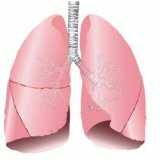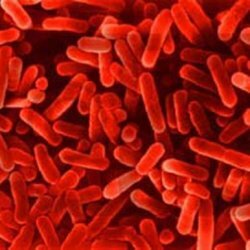Diagnosis and treatment of pulmonary mycoplasmosis
 Mycoplasmas are a group of small microbial parasites that live in the cells of the respiratory tract and are the causative agent of such an infectious disease of the respiratory system as mycoplasmosis. However, mycoplasmas penetrate not only into the respiratory tract - they can also affect the joints and genitourinary system. Mycoplasmosis is often accompanied by sinusitis, bronchitis, pharyngitis and pneumonia. Characteristic for mycoplasmosis symptoms are a slight increase in body temperature, an obsessive dry cough, shortness of breath, a sore throat. Sometimes this disease develops into pneumonia, the symptoms of which almost coincide with the symptoms of influenza. Therefore, the proper diagnosis and treatment of pulmonary mycoplasmosis is very important.
Mycoplasmas are a group of small microbial parasites that live in the cells of the respiratory tract and are the causative agent of such an infectious disease of the respiratory system as mycoplasmosis. However, mycoplasmas penetrate not only into the respiratory tract - they can also affect the joints and genitourinary system. Mycoplasmosis is often accompanied by sinusitis, bronchitis, pharyngitis and pneumonia. Characteristic for mycoplasmosis symptoms are a slight increase in body temperature, an obsessive dry cough, shortness of breath, a sore throat. Sometimes this disease develops into pneumonia, the symptoms of which almost coincide with the symptoms of influenza. Therefore, the proper diagnosis and treatment of pulmonary mycoplasmosis is very important.
Characteristics of mycoplasmas and their reproduction
Mycoplasmas belong to a group of microorganisms that parasitize in the epithelial cells( cover cells) of the respiratory tract. Like the pathogens of chlamydia, the chlamydia of mycoplasma do not have their own apparatus synthesizing energy, they do not have strong walls, therefore, for the existence and reproduction of these microbes use all possible resources of the cells of the body.
As a result, is formed mycoplasmosis?
Firstly, because of their small size, mycoplasma can be placed exclusively inside cells, which allows them to reliably protect themselves from the effects of antibodies and cells of the immune system. Simply put, mycoplasmas simply "hide" in the cells of the human body.
Secondly, mycoplasmas are mobile microorganisms, so in case of death of an infected cell they quickly and easily move to other cells in the intercellular space and infect them.
Thirdly, mycoplasmas have the ability to firmly fix themselves to the cell membranes, as a result of which mycoplasmosis occurs regardless of the number of microbes that have entered the body.
Fourth, penetrating the respiratory tract, inside the cells of the epithelium( that is, the cells that form the surface of the bronchi and trachea), mycoplasmas begin to multiply very quickly and immediately paralyze the functioning of the infected cells.
The most surprising and most important feature of mycoplasmas, which is the cause of the chronic course of mycoplasmosis, is that microorganisms are very similar in structure to certain components of the healthy tissues of the human body. It is for this reason that the immune system of people suffering from mycoplasmosis, practically does not recognize these microorganisms and does not interfere with their development and survival in infected cells and tissues.
In addition, mycoplasmas, along with chlamydia, are resistant to most antibiotics, which greatly complicates the treatment of mycoplasma infection.
Signs and symptoms of pulmonary mycoplasmosis
The onset of pulmonary mycoplasmosis occurs as a result of infection of the organism with a pathogen such as Mycoplasma pneumoniae( Latin Mycoplasma pneumoniae ).According to statistics, mycoplasmosis most often affects children of preschool age, in connection with which there is a great danger of the appearance of a large number of cases in children's groups. Mycoplasma infection is transmitted by airborne droplets, via droplets of saliva and sputum, secreted by a person during a cough. In addition, mycoplasmosis can be infected by contact with various things that have sputum or saliva. So, in children's collectives, the infection can be transmitted through toys, food or, for example, a common chewing gum.
Pulmonary or respiratory mycoplasmosis usually occurs in the form of mycoplasmal pneumonia or bronchitis.
Pulmonary mycoplasmosis begins with perspiration and sore throat, nasal congestion and a pesky dry cough. The latter along with a slight increase in body temperature is often the main symptom of the disease in children. In most cases, parents are not able to distinguish between mycoplasmosis and a mild catarrhal disease and try to cure it themselves using traditional means( expectorants, anti-cough medicines, antibiotics), which, however, does not bring any results.
It should be noted that mycoplasmal pneumonia usually develops in young people and children as a result of complications after mycoplasma bronchitis. Symptomatic mycoplasmal pneumonia is similar to the symptoms of influenza, in particular, patients gradually increase their body temperature to 39 ° C, there is a dry cough and general weakness, weakness, it becomes difficult to breathe( develops shortness of breath).In some cases, cough produces sputum with a small amount of blood or pus. X-ray of the lungs with mycoplasmal pneumonia shows vague shadows - these are the centers of inflammatory processes.
As a rule, mycoplasmal pneumonia proceeds favorably, but sometimes in people with weakened immunity it is possible to develop complications like meningitis, nephritis or arthritis.
The symptoms of pulmonary mycoplasmosis are mostly similar to those of pulmonary chlamydia, an infectious disease that affects the respiratory tract. In addition, both diseases are treated almost identically. At the first signs or suspicion of mycoplasmal or chlamydial infection of the respiratory tract and with an undiagnosed pathogen, you can undergo a trial treatment.
Children with mycoplasmosis may have complications not only in the form of pneumonia and bronchitis: the disease can develop into sinusitis( for example, in sinusitis), and in pharyngitis. Moreover, mycoplasmosis can affect not only the respiratory tract, but also the joints, the genitourinary system.
Diagnosis of mycoplasmosis
- The PCR method is the most sensitive method that determines the structure of microbial DNA.Diagnosis of pulmonary mycoplasmosis with the help of PRC gives the most accurate results. It should be noted that the PRC method requires rather expensive equipment, which is not available in all diagnostic centers.
- The method of detecting specific antibodies determines the traces that appeared as a result of the response of the body's immunity to the presence of mycoplasmas. In people with mycoplasmosis, antibodies such as IgM and IgG are found. In people who have undergone this disease, only antibodies IgG are determined.
Treatment of mycoplasmosis
To begin with, it is necessary to confirm the presence of the disease by conducting a diagnosis, since the treatment of mycoplasmosis does not coincide with the treatment of viral or bacterial bronchitis.
So, with mycoplasmosis appoint:
- The course of antibiotics from the group of tetracycline, macrolides, fluoroquinolones. For example, erythromycin - adults of 500 mg per day, children 50 mg per kg of weight per day. Take 5-6 days.
- At the onset of the disease( 1-2 days) drugs against cough.
- With mycoplasmal pneumonia and bronchitis( to facilitate coughing) - expectorants.



